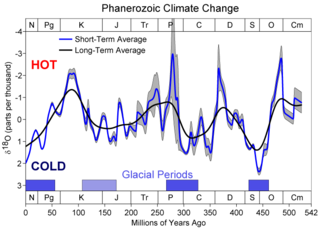THE FIRST ICE AGE ON EARTH
One of the more common types of glacial deposits is called a glacial till, or tillites. These deposits contain unsorted rock fragments ranging in size from pebbles to boulders with a silty or sandy matrix holding everything together. Tillites form as a result of glaciers removing sediment, of varying sizes, from their source and pushing and deposting the sediment like huge icey bulldozers.
The Great Oxygenation
Event
The presence of tillites within the early Proterozoic segment of the geologic record has led geologists to believe that the first glaciers formed about 2.3 billion years ago. The catalyst for this first ice age was a sudden and dramatic change in atmospheric composition. Previously, the Earth’s atmosphere was composed mainly of carbon dioxide and methane, both greenhouse gases, which kept the atmosphere and the surface too warm to support ice formation. However, about 2.4 billion years ago, a rise in oxygen in the atmosphere, also known as the Great Oxygenation Event, sucked up these greenhouse gases.
The Great Oxygenation Event is thought to have been caused by the emergence of plant life on Earth, which led to more uptake of carbon dioxide and a release of oxygen into the atmosphere. As a side note, this event is also referred to as the Oxygenation Catastrophe because of the massing killing off of bacteria that depended on the abundance of carbon dioxide in the atmosphere. As the amount of carbon dioxide in the atmosphere decreased, the entire planet gradually cooled and sheets of ice began to spread across the surface of the Earth. The first period of glaciation on the Earth is referred to as the Huronian glaciation.
Glacial Deposits as
Clues
Other evidence of glacier movement can be found in early Proterozoic rock formations. In areas where Huronian tillites are present, the basement rock contains grooves or striations (a long thin line, mark or strip of colour), that are evidence of glaciers moving pebbles across the rock and scratching it along the way. Since glaciers move in two directions – forward and back – these striations are parallel.
Yet another type of Huronian glacier deposit is a laminated sediment deposit composed of alternating layers of silt and clay. These types of deposits closely resemble the laminated deposits, or varves (a pair of layers of alternately finer and coarser silt or clay believed to comprise an annual cycle of deposition in a body of still water), formed within modern glacial lakes at the front of retreating glaciers. These types of deposits are found in many parts of the world, suggesting that Huronian glaciers were widespread during a time where temperatures on Earth were consistently much cooler than modern temperatures, which are only able to support year-round glaciation at the polar extremes. In fact, one unlikely area where Huronian deposits are found is on the African continent.


The Snow Ball
Earth
The most extensive and well-documented period of glaciation occurred 850 to 630 million years ago during what is called the Cryogenian period of the Neoproterozoic era. Glacier deposits – such as tillites – from this period are found near the equator suggesting that the entire surface of the Earth may have been covered with ice. Geologists even suspect that all the world’s oceans may have been frozen over during this time, leading to the name "SNOW BALL EARTH’ to refer to this phenomenon.


